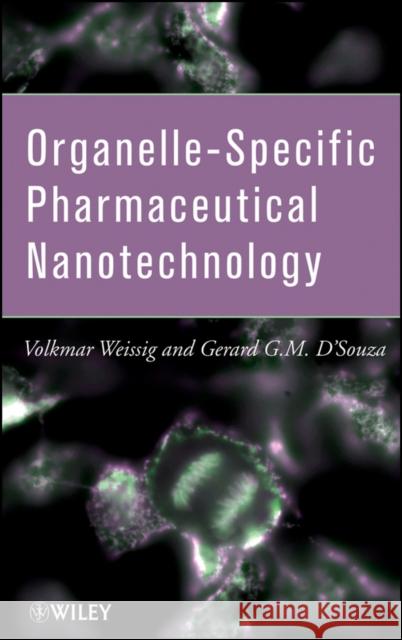Organelle-Specific Pharmaceutical Nanotechnology » książka



Organelle-Specific Pharmaceutical Nanotechnology
ISBN-13: 9780470631652 / Angielski / Twarda / 2010 / 608 str.
Organelle-Specific Pharmaceutical Nanotechnology
ISBN-13: 9780470631652 / Angielski / Twarda / 2010 / 608 str.
(netto: 847,46 VAT: 5%)
Najniższa cena z 30 dni: 878,93
ok. 30 dni roboczych.
Darmowa dostawa!
This title provides a unique focus on the application of nanotechnology to the sub-cellular level with respect to drug delivery and probing inter-cellular milieu. It provides a comprehensive review of the latest in this new, interdisciplinary field of biomedical research.
Wydanie ilustrowane
Preface.
Contributors.
1. An Introduction to Subcellular Nanomedicine: Current Trends and Future Developments (Gerard G. M. D Souza and Volkmar Weissig).
2. Delivery of Nanonsensors to Measure the Intracellular Environment (Paul G. Coupland and Jonathan W. Aylott).
3. Cytoplasmic Diffi usion of Dendrimers and Dendriplexes (Alexander T. Florence and Pakatip Ruenraroengsak).
4. Endocytosis and Intracellular Trafficking of Quantum Dot–Ligand Bioconjugates (Tore–Geir Iversen, Nadine Frerker, and Kirsten Sandvig).
5. Synthesis of Metal Nanoparticle–Based Intracellular Biosensors and Therapeutic Agents (Neil Bricklebank).
6. Subcellular Fate of Nanodelivery Systems (Dusica Maysinger, Sebastien Boridy, and Eliza Hutter).
7. Intracellular Fate of Plasmid DNA Polyplexes (Kevin Maier and Ernst Wagner).
8. Intracellular Trafficking of Membrane Receptor–Mediated Uptake of Carbon Nanotubes (Bin Kang and Yaodong Dai).
9. Real–Time Particle Tracking for Studying Intracellular Transport of Nanotherapeutics (Clive Chen and Junghae Suh).
10. Tracking Intracellular Polymer Localization Via Fluorescence Microscopy (Simon C. W. Richardson).
11. Can QSAR Models Describing Small–Molecule Xenobiotics Give Useful Tips for Predicting Uptake and Localization of Nanoparticles in Living Cells? And If Not, Why Not? (Richard W. Horobin).
12. Self–Unpacking Gene Delivery Scaffolds (Millicent O. Sullivan).
13. Cellular Trafficking of Dendrimers (Yunus Emre Kurtoglu and Rangaramanujam M. Kannan).
14. Endolysosomolytically Active pH–Sensitive Polymeric Nanotechnology (Han Chang Kang and You Han Bae).
15. Uptake and Intracellular Dynamics of Proteins Internalized by Cell–Penetrating Peptides (Arwyn T. Jones).
16. Cargo Transport by Teams of Molecular Motors: Basic Mechanisms for Intracellular Drug Delivery (Melanie J. I. Müller, Florian Berger, Stegan Klumpp, and Reinhard Lipowsky).
17. The Potential of Photochemical Internalization (PCI) for the Cytosolic Delivery of Nanomedicines (Kristian Berg, Anette Weyergang, Anders Høgset, and Pål Kristian Selbo).
18. Peptide–Based Nanocarriers for Intracellular Delivery of Biologically Active Proteins (Seong Loong Lo and Shu Wang).
19. Organelle–Specific Pharmaceutical Nanotechnology: Active Cellular Transport of Submicro– and Nanoscale Particles (Galya Orr).
20. Subcellular Targeting of Virus–Envelope–Coated Nanoparticles (Jia Wang, Mohammad F. Saeed, Andrey A. Kolokoltsov, and Robert A. Davey).
21. Mitochondria–Targeted Pharmaceutical Nanocarriers (Volkmar Weissig and Gerard G.M. D Souza).
22. Cell–Penetrating Peptides for Cytosolic Delivery of Biomacromolecules (Camilla Foged, Xiaona Jing, and Hanne Moerck Nielsen).
23. Therapeutic Nano–object Delivery to Subdomains of Cardiac Myocytes (Valeriy Lukyanenko).
24. Design Parameters Modulating Intracellular Drug Delivery: Anchoring to Specific Cellular Epitopes, Carrier Geometry, and Use of Auxiliary Pharmacological Agents (Silvia Muro and Vladimir R. Muzykantov).
25. Uptake Pathways Dependent Intracellular Trafficking of DNA Carrying Nanodelivery Systems (Ikramy A. Khalil, Yuma Yamada, Hidetaka Akita, and Hideyoshi Harashima).
26. Cellular Interactions of Plasmon–Resonant Gold Nanorods (Qingshan Wei and Alexander Wei).
27. Quantum Dot Labeling for Assessment of Intracellular Trafficking of Therapeutically Active Molecules (Diane J. Burgess and Mamta Kapoor).
Index.
Volkmar Weissig, ScD, PhD, is Associate Professor of Pharmacology at Midwestern University in Glendale, Arizona. He has been actively pioneering mitochondrial pharmaceutics for the last decade. The holder of sixteen patents and author of more than eighty research papers, review articles, and book chapters, Dr. Weissig serves as Associate Editor of the Journal of Liposome Research and is the member of several other editorial boards. He is an active member of the International Liposome Society, the Mitochondria Research Society, the American Association of Pharmaceutical Scientists, and the American Association for the Advancement of Science.
Gerard G.M. D′Souza, PhD, is Assistant Professor of Pharmaceutics at Massachusetts College of Pharmacy and Health Sciences in Boston. He has coauthored more than twenty peer–reviewed publications in the fields of pharmaceutical nanotechnology and mitochondrial pharmaceutics. Dr. D′Souza is a member of the editorial board for the Journal Drug Delivery and serves as a peer reviewer for several journals in the field of drug delivery.
A Comprehensive Review of This New, Interdisciplinary Field of Biomedical Research
The subcellular, organelle–specific delivery of drugs has become the new frontier for drug delivery. Volkmar Weissig helped to initiate this development when, in 1998, he proposed a completely novel approach to delivering drugs to particular cell organelles, namely to mitochondria. A few years later, he was joined by Gerard D′Souza, and since then, they have been pioneering the field of mitochondria–specific drug delivery. Organelle–Specific Pharmaceutical Nanotechnology is their attempt to provide a clear overview of the state of the art in nanotechnology applied to subcellular drug delivery and probing the intercellular milieu in living cells.
This book brings together authors from several scientific disciplines to provide a broad view of the subject. Discussed in full detail are the various approaches to nanocarrier mediated bioactives to cell organelles, as well as emerging research methods for the identification of subcellular targeting ligands and the study of subcellular transport processes. All chapters have been written following a college course like fashion, with a smooth transition from simple principles and methods to more complex material and research being conducted in the field.
Organelle–Specific Pharmaceutical Nanotechnology thus provides "need to know" information to every scientist interested in the development of new and effective nanotechnology–based therapeutic approaches. It will be of particular interest to scientists, postdoctoral investigators, and graduate students in the fields of drug delivery, subcellular transport phenomena, or the design of novel nanotechnological tools for biomedical applications.
1997-2025 DolnySlask.com Agencja Internetowa
KrainaKsiazek.PL - Księgarnia Internetowa









